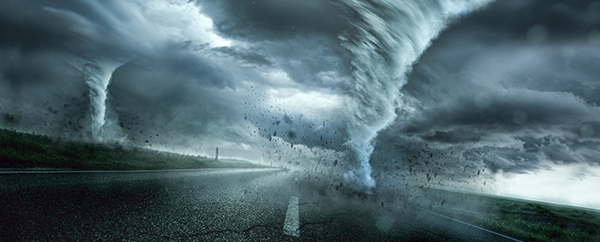Funnel these tornado safety tips to your clients
- Tornadoes generally occur in March-June and between the hours of 3-9 p.m.; however, they can occur at any time of the year under certain conditions.
- Of the 1,200+ tornadoes that touch down in the U.S. annually, truly violent ones account for only two percent of the total. However, they cause 70 percent of all tornado deaths. That means every warning of an impending tornado should be treated with the same life-or-death urgency.
- Learn steps to take to prepare your home and family, along with your business, for a tornado. Also, learn what to do during and after the storm.
In most of the country, twister season starts in just a few days, so we’re providing a list of tornado safety tips to pass along to clients. Officially, the season is April – June, but twisters can occur in just about any month. If you’re a numbers lover, here are a few stats for you:
- Some 1,224 tornadoes touch down every year in the U.S.
- Texas sees the most funnels, followed by Kansas, Oklahoma, Florida, Nebraska and Illinois.
- 227 people are killed annually in a tornado.
- Tornadoes wreak $1.086 billion in damage every year.
- Our worst tornado outbreak was in late April 2011, when 175 twisters killed 316 in Alabama, Georgia, Mississippi, Tennessee and Virginia.
- Peak tornado times are between 3-9 p.m.
- They can generate wind speeds of up to 200 mph, creating damage up to one mile wide and 50 miles long.
Tornadoes are like snowbirds, says USTornadoes.com: They winter in the South (meaning that they can strike there during winter months); then, as the earth warms up, they head north and northwest through the Mid-South and Southeast in early spring, into the Plains and Midwest by summer, and even hit the Canadian border by July, before heading south again for the winter.
Related: Natural disaster aftermath: Employee safety tips
Anyone living in Tornado Alley (Texas, Oklahoma, Kansas, Nebraska, South Dakota and sometimes Iowa, Missouri, Illinois, Indiana and Ohio) knows not to underestimate the power of the funnel force. However, as mobile as society is these days, you may have several clients new to your area who haven’t experienced funnels first-hand and don’t know safety tips.
So we’ve compiled tornado safety tips from Zurich, Insurance Journal and PropertyCasualty360.com for you to provide your clients.
How to prepare at home for a tornado
- Purchase a weather radio, which issues alerts from your local National Weather Service.
- Prepare an emergency kit to keep on hand for the aftermath, that includes water, food, a flashlight, prescriptions and more. WikiHow has an in-depth list with photos; Oklahoma’s Emergency Medical Services Authority also has a list.
- Ensure your home inventory is up-to-date, whether it’s a list, a series of photos or a video, to help you in reporting losses. Be sure to capture images of valuables such as artwork, antiques, firearms, jewelry, etc. Save these photos and inventory to the cloud or someplace where you can easily access them afterward.
- Pick your safe place: At home, keep a clear path to your basement, if you have one. Or choose an interior room or closet on the lowest floor. Put as many walls between you and the exterior as possible. At work, decide now where to go if a warning is given.
- Know the terms: Tornado Watch means just that: Watch. Be on the lookout, because conditions are looking like a twister is a good possibility. Tornado Warning: A funnel has been spotted; head to your safe spot now.
- When a Watch is issued, secure outside items that could become projectiles such as outdoor furniture, trash cans, etc. – if it’s safe to do so. Move vehicles inside the garage. If you’re in a mobile home, re-check your tie-downs and be ready to move to a safer location.
- If you’re in the car when a Warning is issued, drive to a nearby safe spot if possible. If not, get away from your vehicle and into the lowest spot possible, such as a ditch. Insurance Journal warns that under a bridge may not be a safe spot, because winds can roar greater due to a change in air pressure when the funnel passes over.
- If at home when the Warning sounds, grab cushions, pillows or a mattress to use as a cover against flying debris.
How to prepare your business for a tornado
First, create your tornado preparedness strategy.
- Identify the safest areas in your building and mark them as a tornado shelter.
- Make sure all employees know where these are.
- Zurich suggests naming “tornado wardens,” whose job is to ensure everyone in their area – including customers and visitors – gets to a safe spot.
- In case of building damage, determine where employees will work until the building is safe and fully functioning. What equipment and supplies will they need?
- Do you need a backup generator in case you lose power?
- Purchase an ample supply of flashlights, batteries and first-aid kits
Next, when the weather looks threatening and a Watch has been sounded, follow these steps:
- Secure any outdoor items that could become airborne missiles
- Move computer servers and other vital equipment in tornado-resistant areas of the building.
Related: Fire prevention and safety tips for your business
During a tornado, at home or work
People are your first priority, as always. Make sure everyone has moved either to a tornado shelter or in a building, to the basement or an inside hallway with no windows or doors. If you have an inside room, have everyone seek cover beneath a table or desk.
At home, your safe space may be inside a bathtub with couch cushions covering you. At either location, be sure to have cell phones with you.
After a tornado
At home or work, watch for hazards caused by the storm, such as leaking gas or flammables, downed power lines or exposed wiring. When moving debris, watch for snakes.
At home, ensure everyone is safe and healthy. At work, have your tornado wardens check in via walkie-talkie or cell phone as to how many and who are with them, and their safety conditions.
Very often warnings are issued in mere seconds before a tornado hits, so encourage your clients to use these tornado safety tips to prepare now before the storms are forecast.

